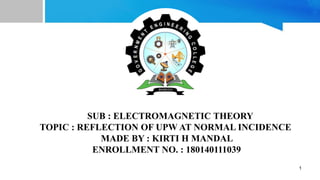
EMW Theory - Reflection & SWR
- 1. SUB : ELECTROMAGNETIC THEORY TOPIC : REFLECTION OF UPW AT NORMAL INCIDENCE MADE BY : KIRTI H MANDAL ENROLLMENT NO. : 180140111039 1
- 2. INTRODUCTION • Plane waves reflection from a media interface includes two parts : – normal incidence and oblique incidnence – normal incidence can be further divided based on different types of medium 1. lossy medium 2. good conductor 3. lossless medium 4. perfect conductor 2
- 3. INTRODUCTION • In practical scenarios of wireless and mobile communications the waves are reflected back at the surface while entering another medium . • Reflected wave depends on the type of the medium . • And also the strength of the reflected wave is less than that of the incident wave or equal to it in some condition . • The ratio of (reflected wave / incident wave ) is known as the “Reflection coefficient” • Which is basically symbolised by a “Gamma “. 3
- 4. INTRODUCTION The ratio depends on • conductivity • permitivity • permeability of the medium • Some part of the wave will reflect back while some will be trannsmitted through the medium . • The transmitted wave ratio is also dependant on the parameters stated above. • The ratio of the transmitted wave and incident wave is known as “Transmission coefficient “. 4
- 5. REFLECTION OF UPW AT NORMAL INCIDENCE • To find out total reflected wave and transmitted wave we need to take into consideration the parameters of the medium and to find the reflection and transmitted coefficient and their relation ,we will have to find the reflected ,transmitted and incident waves. 5
- 6. REFLECTION OF UPW AT NORMAL INCIDENCE • This is basically boundary value problem with boundary conditions at z=0 • Total electric and magnetic field are tangential to the interface at z=0. • similarly,the transmitted electric and magnetic field are also tangential at z=0. • Also note that there are no surface current density at the surface. • Hence , the tangential components of electric and magnetic fields must be continuous at the boundary z=0. • So, Ei+Er= Et at z=0 6
- 7. CONTIUATION 7 ) 2 / 1 ( ) 1 / 1 ( ) 2 / ( ) 1 / 1 ( Therefore, from here we will get reflection coefficient and transmission coefficient in the form of intrinsic impedance ) 2 1 /( 2 2 ) 1 2 / 1 2 ( 1 1 1 2 / 1 2
- 8. STANDING WAVE RATIO • Standing wave ratio is mathematical exoression of the non-uniformity of an EM field on a transmission line such as coaxial cable.Usually,SWR is defined as the ratio of the maximum radio frequency to the minimum. • SWR =Emax/Emin • Standing wave is basically formed when the uniform wave is travelling through a lossless region to good conductor . • In that situation the total reflected waves combine with the incident wave and forms standing wave pattern. • standing wave = incident wave +reflected wave 8
- 9. SWR 9 • AIR TO GOOD CONDUCTOR – no transmitted wave and hence total reflection • LOSSLESS TO LOSSLESS – In that case a more complicated situation arises when the reflected field is neither 0 nor 100. – And hence we go for SWR and is expressed by the ratio of the maximum amplitude found by the proe to minimum amplitude. • Case 1 : n1=n2 ,no standing wave is present • Case 2 : n2>n1 ,some portion will transmit rest will reflect back